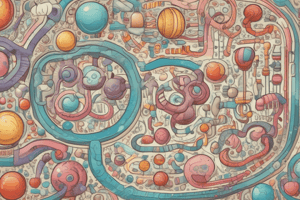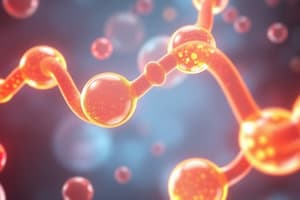Podcast
Questions and Answers
Which amino acid is purely ketogenic?
Which amino acid is purely ketogenic?
- Leucine (correct)
- Isoleucine
- Tryptophan
- Phenylalanine
Which classification does Methionine belong to based on nutritional requirements?
Which classification does Methionine belong to based on nutritional requirements?
- Purely glucogenic
- Semi-essential amino acids
- Essential amino acids (correct)
- Non-essential amino acids
Which type of amino acid has an aliphatic side chain?
Which type of amino acid has an aliphatic side chain?
- Imino acid
- Aromatic amino acids
- Heterocyclic amino acids
- Aliphatic amino acids (correct)
Which amino acid is classified as semi-essential?
Which amino acid is classified as semi-essential?
Which amino acid enters both ketogenic and glucogenic pathways?
Which amino acid enters both ketogenic and glucogenic pathways?
Which amino acid belongs to the subclass of hydroxy amino acids?
Which amino acid belongs to the subclass of hydroxy amino acids?
Which amino acid is considered an aromatic amino acid?
Which amino acid is considered an aromatic amino acid?
Which amino acids have nonionic polar side chains?
Which amino acids have nonionic polar side chains?
Which subclass does Glutamic acid belong to?
Which subclass does Glutamic acid belong to?
Which derived amino acid is known for containing sulfur?
Which derived amino acid is known for containing sulfur?
Flashcards are hidden until you start studying
Study Notes
Classification of Amino Acids
Classification Based on Metabolism
- Purely ketogenic amino acids enter the ketogenic pathway, e.g., Leucine
- Ketogenic and glucogenic amino acids enter both ketogenic and glucogenic pathways, e.g., Lysine, Isoleucine, Phenylalanine, Tyrosine, and Tryptophan
- Purely glucogenic amino acids enter the glucogenic pathway, e.g., all the remaining 14 amino acids
Classification Based on Nutritional Requirements
- Essential amino acids are not synthesized by the human body and need to be taken through food, e.g., Methionine, Threonine, Tryptophan, Valine, Isoleucine, Leucine, Phenylalanine, and Lysine
- Semi-essential amino acids are required in food for growing children, but not for adults, e.g., Arginine and Histidine
- Non-essential amino acids are synthesized by the human body and do not need to be taken through food, e.g., all the remaining 10 amino acids
Classification Based on Structure
- Aliphatic amino acids have an aliphatic side chain
- Aromatic amino acids have an aromatic side chain, e.g., Phenylalanine and Tyrosine
- Heterocyclic amino acids have a ring with more than one kind of atoms on the side chain, e.g., Tryptophan and Histidine
- Imino acid has a side chain attached to the amino group, e.g., Proline
- Derived amino acids are compounds derived from amino acids, e.g., Hydroxy proline and hydroxy lysine, Citrulline and Homocysteine, and Gamma Amino Butyric Acid (GABA)
Classification Based on Structure (Subclasses)
- Aliphatic amino acids can be subclassified into:
- Mono amino mono carboxylic acids, e.g., Glycine, Alanine
- Mono amino dicarboxylic acids, e.g., Aspartic acid, Glutamic acid
- Di basic mono carboxylic acids, e.g., Lysine, Arginine
- Branched chain amino acids, e.g., Valine, Leucine, Isoleucine
- Hydroxy amino acids, e.g., Serine, Threonine
- Sulphur containing amino acids, e.g., Cysteine, Methionine
- Amino acids with amide group, e.g., Asparagine, Glutamine
Classification Based on Side Chain
- Amino acids with nonpolar side chains, e.g., Alanine, Valine, Leucine, Isoleucine, Methionine, Proline, Phenylalanine, and Tryptophan
- Amino acids with nonionic polar side chains, e.g., Glycine, Serine, Threonine, Cysteine, Tyrosine, Glutamine, and Asparagine
Studying That Suits You
Use AI to generate personalized quizzes and flashcards to suit your learning preferences.




